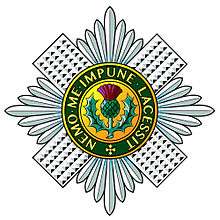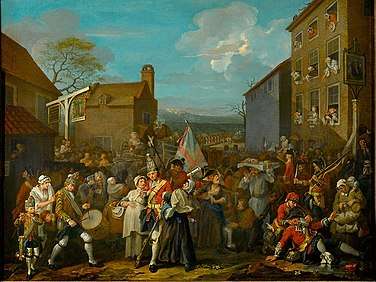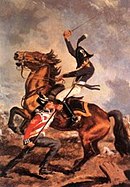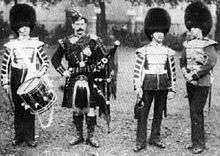Scots Guards
The Scots Guards (SG), is one of the Foot Guards regiments of the British Army. Their origins lie in the personal bodyguard of King Charles I of England and Scotland. Its lineage can be traced back to 1642, although it was only placed on the English Establishment (thus becoming part of what is now the British Army) in 1686. It is the oldest formed Regiment in the Regular Army, more so than any other in the Household Brigade. [1]
| The Scots Guards | |
|---|---|
 Regimental badge of the Scots Guards | |
| Active | 1642–1651 1662–present |
| Country | (1642–1651) (1662–1707) (1801–present) |
| Branch | |
| Type | Foot Guards |
| Role | 1st Battalion Scots Guards – Mechanized Infantry F Company – Public Duties |
| Size | One battalion One company |
| Part of | Guards Division |
| Garrison/HQ | RHQ – London 1st Battalion – Aldershot F Company – London |
| Nickname(s) | The Kiddies; Jock Guards |
| Motto(s) | "Nemo Me Impune Lacessit" (Latin) "No one assails me with impunity" |
| March | Quick – Highland Laddie Slow – The Garb of Old Gaul |
| Anniversaries | St Andrew's Day Nov 30 Battle of Mount Tumbledown Jun 13 |
| Commanders | |
| Colonel-in-Chief | Elizabeth II |
| Colonel of the Regiment | Prince Edward, Duke of Kent KG, GCMG, GCVO |
| Insignia | |
| Tactical Recognition Flash |  |
| Tartan | Royal Stewart (pipers kilts, trews and plaids) |
| Plume | none |
| Abbreviation | SG |
History
Formation; 17th Century
The regiment now known as the Scots Guards traces its origins to the Marquis of Argyll's Royal Regiment, a unit raised in 1642 by Archibald Campbell, 1st Marquess of Argyll in response to the 1641 Irish Rebellion.[2] After the Restoration of Charles II, the Earl of Linlithgow received a commission dated 23 November 1660 to raise a regiment which was called The Scottish Regiment of Footguards.[3]
It served in the 1679 Covenanter rising of 1679, as well as Argyll's Rising in June 1685, after which it was expanded to two battalions.[4] When the Nine Years War began in 1689, the first battalion was sent to Flanders; the second served in Ireland, and fought at the 1690 Battle of the Boyne, before joining the First in 1691.[5] The combined unit fought at Steenkerque and Landen, as well as the 1695 Namur. After the Treaty of Ryswick in 1697, the regiment returned to Scotland.[6]
18th Century

The Guards remained in Scotland during the War of the Spanish Succession; retitled The Third Regiment of Foot Guards, it moved to London in 1712, and did not return to Scotland for another 100 years. During the 1740-1748 War of the Austrian Succession, the First Battalion served at Dettingen in 1743 and Fontenoy in April 1745, a British defeat famous for the Gardes françaises and Grenadier Guards inviting each other to fire first.[7]
Both battalions were in London during the 1745 Rising; an engraving by William Hogarth shows them marching to take up defensive positions in North London. However, the Jacobite army turned back at Derby, and in July 1747, the Second Battalion was sent to Flanders, where it fought at Lauffeld, before the war ended with the Treaty of Aix-la-Chapelle.[8]
In the absence of a modern police force, the military was often used for crowd control; in 'Memoirs of a Georgian Rake,' William Hickey describes a detachment from the 'Third Regiment of Guards, principally Scotchmen' dispersing a crowd attempting to release the radical politician, John Wilkes from prison in 1768.[9]
1805–1913

In April 1809, the 1st Battalion was sent to the Iberian Peninsula, and served in the Peninsular War in Portugal and Spain. It took part in the crossing of the River Douro on 12 May, an operation that ended so successfully that the French Army were in full retreat to Amarante after the actions in Oporto and its surrounding areas. In late July 1809 the regiment took part in the Battle of Talavera, one of the bloodiest and most bitter of engagements during the war.[2]
The 2nd Battalion's flank companies took part in the disastrous Walcheren Campaign in the Low Countries. The 1st Battalion went on to take part in the Battle of Fuentes de Oñoro in May 1811, the Battle of Salamanca in July 1812, the Siege of San Sebastián in Summer 1813 and the Battle of the Nive in December 1813.[2]
At the Battle of Waterloo in June 1815, the Scots Guards were positioned on the ridge just behind Hougoumont. Their light companies, commanded by Lieutenant-Colonel James Macdonnell, held Hougoumont Farm throughout the battle, a key defensive position on the right flank of the Allied army.[11]

1914–1945
The First World War
The 1st Battalion, part of the 1st (Guards) Brigade of the 1st Division, was part of the British Expeditionary Force which arrived in France in 1914. The Battalion took part in the Battle of Mons in August 1914, the First Battle of the Marne in September 1914 and the Battle of the Aisne also in September 1914. The 1st and 2nd Battalions then took part in the First Battle of Ypres in November 1914, the Battle of Aubers Ridge in May 1915 and the Battle of Loos in September 1915. In July 1916 the Scots Guards took part in the first Battle of the Somme and in July 1917, the regiment began its involvement in the Battle of Passchendaele. In March 1918 they fought at the second Battle of the Somme and in Autumn the regiment took part in the final battles of the war on the Western Front.[12]
The Second World War
In April 1940, the 1st Battalion, as part of the 24th Guards Brigade, took part in its first campaign of the war, during the expedition to Norway. In North Africa, as part of the 22nd Guards Brigade, the 2nd Battalion took part in fighting against the Italians in Egypt followed by tough fighting in Libya, then also controlled by Italy. In North Africa, in March 1943, the 2nd Battalion took part in the defensive Battle of Medenine, after the Germans had counter-attacked the Allies.[13]
In September 1943, the 2nd Battalion, as part of the 201st Guards Brigade of the 56th (London) Division, took part in the Landing at Salerno. In December 1943, the 1st Battalion, as part of 24th Guards Brigade, arrived in the Italian Theatre. At the Battle of Monte Cassino in early 1944, the 2nd Battalion suffered heavy casualties in tough fighting.[14]
The 1st Battalion, as part of its brigade, joined the 6th South African Armoured Division in May 1944. The regiment took part in many fierce engagements throughout 1944, including those against the Gothic Line, a formidable defensive line.[15]
Since 1946

The 2nd Battalion was once more involved in war when it deployed to Malaya to fight in the Malayan Emergency against anti-colonial rebels of the Malayan National Liberation Army. During their time in Malaya the Scots Guards were involved in the Batang Kali massacre in which 24 unarmed civilians were killed.[16] Then in late 1951, the 1st Battalion was deployed to Cyprus and in February 1952, the battalion deployed to the Suez Canal Zone, Egypt. Both the 1st and 2nd Battalion deployed to Northern Ireland during the Troubles in the early 1970s.[17]
During the Falklands War in 1982 the main force of the Scots Guards began its advance on the western side of Mount Tumbledown. During the course of the battle in the early hours of 14 June 1982, men of the 2nd Battalion 'wearing berets instead of helmets' launched a bayonet charge on the stout Argentinian defenders which resulted in bitter and bloody fighting, and was one of the last bayonet charges by the British Army.[14]
In 2004 the 1st Battalion deployed to Iraq on a 6-month posting as part of 4th Armoured Brigade. The 4th Brigade relieved 1st Mechanised Brigade, and joined the Multi-National Division (South East), which was under UK command.[18]
The 1st Battalion will move back to Bourlon Barracks and fall under the command of the new Strike Brigade as a result of the Army 2020 Refine reforms.[19]
_patrolling_near_Musa_Qala%2C_Afghanistan._MOD_45149486.jpg)
Traditions and affiliations
The Scots Guards and other Guards regiments have a long-standing connection to the Parachute Regiment. Guardsmen who have completed the P company selection course are transferred into the Guards Parachute Platoon, who are currently attached to 3 PARA. This continues the lineage of the No. 1 (Guards) Independent Parachute Company, who were the original Pathfinder Group of the 16th Parachute Brigade.[20]
The Scots Guards is ranked as the third regiment in the Guards Division. As such, Scots Guardsmen can be recognised by having the buttons on their tunics spaced in threes.[14]
Structure and Role
The regiment consists of a single operational battalion, which was based in Catterick between 2008 and 2015, thereafter moving to Aldershot in the armoured infantry role. As part of Army 2020 the battalion moves back to Catterick. The 1st Battalion Scots Guards has five operational companies: three mechanized companies (Right Flank, C Company and Left Flank), one Support Weapons company (B Company) and one headquarters and logistics company (HQ Company).[21] Since 1993, F Company, permanently based in Wellington Barracks, London on public duties, has been the custodian of the colours and traditions of the 2nd Battalion, which was placed in permanent suspended animation in 1993 as a result of Options for Change.[22] 1st Battalion will be equipped with Mastiff Vehicles (and later the Mechanised Infantry Vehicle (MIV)) under Army 2020 Refine and be under the first Strike Brigade. The 1st Battalion will not rotate public ceremonial duties unlike the other guards regiments with F Company performing that role.[23][24][25][26]
Training
Recruits to the Guards Division go through a thirty-week gruelling training programme at the Infantry Training Centre (ITC). The training is two weeks more than the training for the Regular line infantry regiments of the British Army; the extra training, carried out throughout the course, is devoted to drill and ceremonies.[27]
Regimental colonels
Regimental colonels have included:
- Major-General George Livingston, Earl of Linlithgow, 1660–1684;[28]
- Lieutenant-General James Douglas, 1684–1691; died of disease at Namur in the Spanish Netherlands.[29]
- Lieutenant-General, George Ramsay, 1691–1705; died in Edinburgh, September 1705;[28]
- Lieutenant-General William Kerr, Marquess of Lothian, April 1707–1713; deprived of the Colonelcy for political reasons;[30]
- General The Earl of Dunmore 1713–1752[28]
- General The Earl of Rothes 1752–1767[28]
- Field Marshal The Duke of Gloucester 1767–1770[28]
- General The Earl of Loudoun 1770–1782[28]
- Field Marshal The Duke of Argyll 1782–1806[28]
- Field Marshal The Duke of Gloucester 1806–1834[28]
- General The Duke of Gordon 1834–1836[28]
- General The Earl Ludlow 1836–1842[28]
- Field Marshal Prince Albert of Saxe-Coburg and Gotha 1842–1852[28]
- Field Marshal The Duke of Cambridge 1852–1861[28]
- Field Marshal Sir Alexander Woodford 1861–1870[28]
- General Sir John Aitchison 1870–1875[28]
- General Lord Rokeby 1875–1883[28]
- General Sir William Knollys 1883–1883[31]
- Field Marshal The Duke of Connaught and Strathearn 1883–1904[32]
- Field Marshal Lord Methuen 1904–1932[32]
- Field Marshal The Duke of York 1932–1936[33]
- Field Marshal The Duke of Gloucester 1936–1974[33]
- Field Marshal The Duke of Kent 1974–present[33]
Battle honours
The battle honours of the Scots Guards are as follows:[34]
- Pre-First World War: Namur 1695, Dettingen, Lincelles, Egypt, Talavera, Barrosa, Fuentes de Oñoro, Salamanca, Nive, Peninsula, Waterloo, Alma, Inkerman, Sevastopol, Tel-er-Kebir, Egypt 1882, Suakin 1885, Modder River, South Africa 1899–1902
- First World War:
- Western Front: Retreat from Mons, Marne 1914, Aisne 1914, Ypres 1914 1917, Langemarck 1914, Gheluvelt, Nonne Bosschen, Givenchy 1914, Neuve Chapelle, Aubers, Festubert 1915, Loos, Somme 1916 1918, Flers–Courcelette, Morval, Pilckem, Poelcapelle, Cambrai 1917 1918, St. Quentin, Albert 1918, Bapaume 1918, Arras 1918, Drocourt-Quéant, Hindenburg Line, Havrincourt, Canal du Nord, Selle, Sambre, France and Flanders 1914–18
- Second World War:
- North-West Europe: Stien, Norway 1940, Quarry Hill, Estry, Venlo Pocket, Rhineland, Reichswald, Kleve, Moyland, Hochwald, Rhine, Lingen, Uelzen, North-West Europe 1944–45
- North Africa: Halfaya 1941, Sidi Suleiman, Tobruk 1941, Gazala, Knightsbridge, Defence of Alamein Line, Medenine, Tadjera Khir, Medjez Plain, Grich el Oued, Djebel Bou Aoukaz 1943 I, North Africa 1941–43
- Italy: Salerno, Battipaglia, Volturno Crossing, Rocchetta e Croce, Monte Camino, Campoleone, Carroceto, Trasimene Line, Advance to Florence, Monte San Michele, Catarelto Ridge, Argenta Gap, Italy 1943–45
- Post World War II: Tumbledown Mountain (Falkland Islands 1982), Gulf 1991
Alliances
.svg.png)

Order of precedence
| Preceded by Coldstream Guards |
Infantry Order of Precedence | Succeeded by Irish Guards |
References
- "Scots Guards". www.army.mod.uk. Retrieved 27 March 2019.
- "Scots Guards". British Empire. Retrieved 27 April 2014.
- Dalton 1896, p. 3.
- Dalton 1896, p. 51.
- Dalton 1896, p. 85.
- Folker.
- McKinnon 1883, p. 368.
- History.
- Hickey 1995, pp. 53–55.
- "Scots Guards". www.scotsguards.co.uk. Retrieved 2 September 2018.
- Longford 1971, p. 450.
- "The Wartime Memories Project – The Great War". Retrieved 27 April 2014.
- "The Battle Of Medenine". Queen's Royal Surreys (Archived). Retrieved 6 February 2020.
- "The Scots Guards – Ex Servicemen Recruitment". Retrieved 27 April 2014.
- "6th South African Armoured Division". Retrieved 27 April 2014.
- "Revealed: how Britain tried to legitimise Batang Kali massacre". The Guardian. 6 May 2012. Retrieved 19 January 2019.
- "Scots Guards". British Army units 1945 on. Retrieved 27 April 2014.
- "Scots Guards". Archived from the original on 8 June 2012. Retrieved 27 April 2014.
- "Scots Guards". www.army.mod.uk. Retrieved 21 January 2019.
- "No 1 (Guards) Independent Parachute Company". ParaData. Retrieved 26 April 2014.
- "Our Fighting Role". Scots Guards. Retrieved 26 September 2018.
- "Our Ceremonial Role". Scots Guards. Retrieved 26 November 2018.
- "Regular Army basing matrix" (PDF). Archived from the original (PDF) on 14 August 2016. Retrieved 27 April 2014.
- "Strategic Defence and Security Review - Army:Written statement - HCWS367 - UK Parliament". Parliament.uk. 15 December 2016. Retrieved 27 August 2017.
- "Role of Scots Guards under Army 2020 model" (PDF). Ministry of Defence,UK. 25 April 2018. Retrieved 23 November 2018.
- Army Secretariat (10 March 2017). "Response to FOI2017/02130 - Request for information related to Army 2020 Refine" (PDF). publishing.service.gov.uk. Retrieved 24 November 2018.
- "Combat Infantryman's Course – Foot Guards". Ministry of Defence. Retrieved 27 April 2014.
- "Scots Guards Colonels". British Empire. Retrieved 1 May 2014.
- Collins, Arthur; Brydges, Sir Egerton (1812). Peerage of England: Genealogical, Biographical, and Historical. 8. F.C. and J. Rivington and others. p. 65.
- Handley, Stuart (2004). "Kerr, William, second marquess of Lothian". doi:10.1093/ref:odnb/15469. Cite journal requires
|journal=(help) - "Sir William Knollys". Oxford Dictionary of National Biography. Retrieved 1 May 2014.
- "No. 27672". The London Gazette (Supplement). 2 May 1904. p. 2837.
- "History of the Scots Guards". Retrieved 30 April 2014.
- "Scots Guards Sword". Retrieved 27 April 2014.
Sources
- Dalton, Charles (1896). English Army Lists and Commission Registers, 1661-1714, Vol. IV (2018 ed.). London: Forgotten Books. ISBN 978-1333543266.
- Folker, Martin. "3rd Foot Guards (Or Scotch Guards)". War of the Spanish succession. Retrieved 17 June 2020.
- Hickey, William (1995). Memoirs of a Georgian Rake. The Folio Society.
- Longford, Elizabeth (1971). Wellington; The years of the sword. HarperCollins Publishers Ltd. ISBN 978-0586035481.
- McKinnon, Daniel (1883). Origins and Services of the Coldstream Guards, Volume I. Richard Bentley.
- "History". Scots Guards Association. Retrieved 1 November 2018.
External links
| Wikimedia Commons has media related to Scots Guards. |